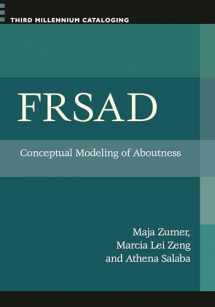
FRSAD: Conceptual Modeling of Aboutness (Third Millennium Cataloging)
Book details
Summary
Description
The first comprehensive exploration of the development and use of the International Federation of Library Associations and Institutions' (IFLA) newly released model for subject authority data, covering everything from the rationale for creating the model to practical steps for implementing it.
FRSAD: Conceptual Modeling of Aboutness explores the full dimensions of the IFLA's Functional Requirements for Subject Authority Data model, showing how putting the model to work can ease information sharing across systems, domains, and environments.
Written by three leading members of the IFLA working group that developed the model, FRSAD moves from the theoretical foundations of knowledge organization to a complete conceptual overview of the model, to specific working guidelines for its implementation. The book is filled with insights into the factors driving the model's development, as well as numerous illustrative examples of its practical applications in real-world settings. It also focuses on the benefits of using the model when developing knowledge organization systems (KOS) within the library domain and beyond.


We would LOVE it if you could help us and other readers by reviewing the book
Book review



